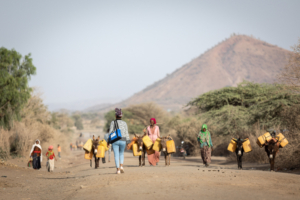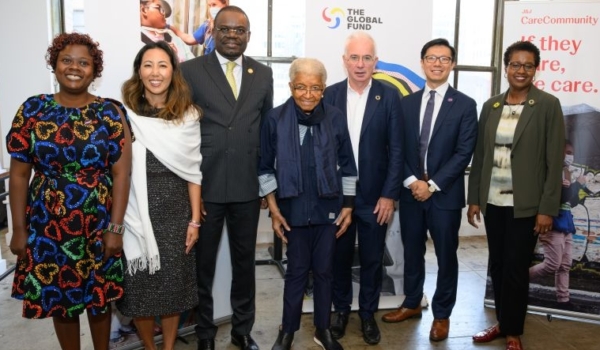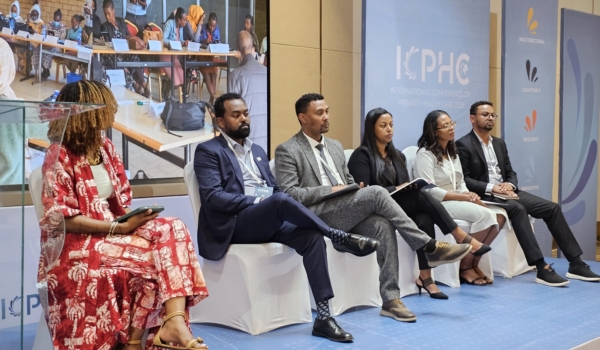Our vision is a world where a health worker is within reach of everyone, everywhere. Here’s what that world could look like in one remote community.
It’s early morning as you set off down the path. Already, the sun is warm on your shoulders, and you have a busy day ahead. As the only community health worker for miles around, your entire community depends on you. There’s the young couple eager to welcome their first child: the expectant mother relies on you to conduct her antenatal checkups, and when the time comes, you’ll help coordinate her transport to the nearest clinic for her delivery.
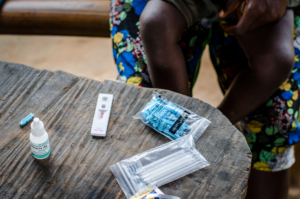 There’s the little boy from the home next to hers—last month his mother noticed he had a fever, and you used a rapid diagnostic test to diagnose him with malaria and then provided treatment right in his own home.
There’s the little boy from the home next to hers—last month his mother noticed he had a fever, and you used a rapid diagnostic test to diagnose him with malaria and then provided treatment right in his own home.
And there’s your closest neighbor, a mother of three whose youngest child was born just three months ago at the health facility. Today, she and her baby girl will be the first patients you visit.
 When you arrive, your neighbor welcomes you in. She answers your questions about her health and the health of her baby, and she wants to know—Is my daughter growing the way she should be? Is she getting enough to eat? To check for malnutrition, you use a measuring tape to perform a middle-upper arm circumference screening, a skill you learned when you first trained to become a community health worker.
When you arrive, your neighbor welcomes you in. She answers your questions about her health and the health of her baby, and she wants to know—Is my daughter growing the way she should be? Is she getting enough to eat? To check for malnutrition, you use a measuring tape to perform a middle-upper arm circumference screening, a skill you learned when you first trained to become a community health worker.
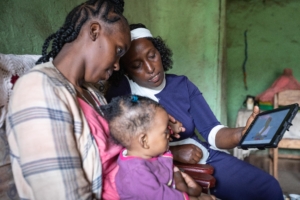 To help your neighbor understand the test, you take out your tablet and find a video that shows a mother like her with her own baby. Last month, when you completed your regular refresher training, the facilitator shared this resource with you. Today, when you share it with your neighbor, she’s reassured: like the baby in the video, her daughter’s arm measurement falls within the green section of the tape. She’s growing just the way she should be.
To help your neighbor understand the test, you take out your tablet and find a video that shows a mother like her with her own baby. Last month, when you completed your regular refresher training, the facilitator shared this resource with you. Today, when you share it with your neighbor, she’s reassured: like the baby in the video, her daughter’s arm measurement falls within the green section of the tape. She’s growing just the way she should be.
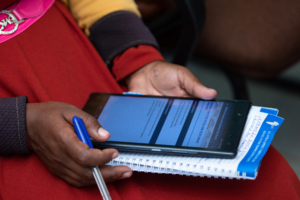 Before you leave your neighbor’s house, you switch to the case management portal on your tablet. When you first started working, you had to fill out paper forms for every visit to every patient—a time-consuming process. But now, you easily manage each case on a digital health system. When you meet with your supervisor next week, she will help you look at any tricky cases where you want support, and she’ll make sure you’ve submitted your patient reports.
Before you leave your neighbor’s house, you switch to the case management portal on your tablet. When you first started working, you had to fill out paper forms for every visit to every patient—a time-consuming process. But now, you easily manage each case on a digital health system. When you meet with your supervisor next week, she will help you look at any tricky cases where you want support, and she’ll make sure you’ve submitted your patient reports.
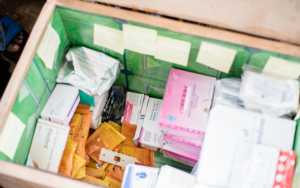 If there is an outbreak of TB, malaria, or even a new sickness, the Ministry of Health will notice it, your supervisor explains, emphasizing that you’re part of a well-connected system that covers communities in every district of the country. Through thousands of community health workers’ reports, the Ministry tracks healthcare coverage, identifies potential health threats, and gets a bigger picture of the changes that have happened in communities like yours. They’ll use the data to refine the systems, trainings, and practices that support you, ensuring you can provide even better care. They’ll also make certain you get the supplies you need to care for your patients.
If there is an outbreak of TB, malaria, or even a new sickness, the Ministry of Health will notice it, your supervisor explains, emphasizing that you’re part of a well-connected system that covers communities in every district of the country. Through thousands of community health workers’ reports, the Ministry tracks healthcare coverage, identifies potential health threats, and gets a bigger picture of the changes that have happened in communities like yours. They’ll use the data to refine the systems, trainings, and practices that support you, ensuring you can provide even better care. They’ll also make certain you get the supplies you need to care for your patients.
 As you leave your neighbor’s house, you are happy to know her baby is thriving—and you’re proud that the family trusts your advice. They know you have been trained to give them the care they need—and that you are their link to the health system. You are proud of the work you do and the changes you’ve seen. The salary you earn helps pay for your own children’s school fees, and your oldest child tells you she wants to be a health worker like you someday. She tells you, I want to help people, like you do.
As you leave your neighbor’s house, you are happy to know her baby is thriving—and you’re proud that the family trusts your advice. They know you have been trained to give them the care they need—and that you are their link to the health system. You are proud of the work you do and the changes you’ve seen. The salary you earn helps pay for your own children’s school fees, and your oldest child tells you she wants to be a health worker like you someday. She tells you, I want to help people, like you do.
There’s a long day ahead. Already, you’re thinking of your next patient. There is more work to be done, today and every day. But seeing your neighbors healthy and happy drives you—and makes your journey worthwhile.
You walk on.

